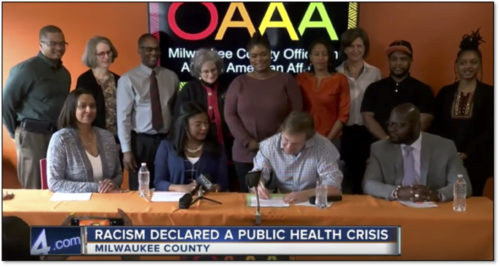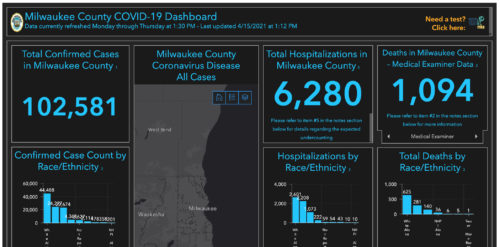Milwaukee helping shape a national conversation on racism as a public health crisis
Share
Explore Our Galleries
Breaking News!
Today's news and culture by Black and other reporters in the Black and mainstream media.
Ways to Support ABHM?
By: Mary Spicuzza and Alison Dirr, Milwaukee Journal Sentinel
Milwaukee put race front and center as it tracks COVID-19’s toll.

Inequality can be deadly.
Milwaukee was among the first counties to reveal how deadly when the coronavirus pandemic struck just over a year ago. By tracking and publicly sharing demographic data, officials here quickly recognized what soon became a troubling national trend: COVID-19 was devastating Black and Latino communities.
It started with a map of cases Milwaukee County officials posted online during the early weeks of the pandemic, which showed clusters of cases forming in Sherman Park and other predominantly Black communities on the city’s north side. Soon, outbreaks hit Latino neighborhoods on the south side.
But their efforts actually began even before COVID-19 struck, with a pair of declarations, by the county and the city, that racism is a public health crisis.
Those declarations — now echoed by communities around the country and the head of the U.S. Centers for Disease Control and Prevention — helped shape how officials have responded to the pandemic, and how willing they’ve been to share information with the public….
“There was some real intention with regard to recognizing COVID as yet another reflection on the impact of racism on the Black community,” U.S. Rep. Gwen Moore, D-Milwaukee, said of her conversations with local leaders in the early days of the pandemic.
Last week, the head of the CDC acknowledged racism is a serious threat to public health nationwide. In a statement, CDC director Rochelle Walensky noted that more than 500,000 Americans had died of coronavirus and tens of millions had been infected.
“These painful experiences and the impact of COVID-19 are felt, most severely, in communities of color — communities that have experienced disproportionate case counts and deaths, and where the social impact of the pandemic has been most extreme,” she said.
“Yet, the disparities seen over the past year were not a result of COVID-19. Instead, the pandemic illuminated inequities that have existed for generations and revealed for all of America a known, but often unaddressed, epidemic impacting public health: racism.”
The patterns that emerged on Milwaukee’s map mirror disparities that have long been documented with other health conditions, such as heart attacks and strokes, said Ben Weston, director of medical services for the Milwaukee County Office of Emergency Management….

County Executive David Crowley said he believes Milwaukee made a difference nationally.
“We were one of the very first in the country to explicitly track this data based on race,” he said….

Thirty-three of the first 45 people who died from complications of COVID-19 in Milwaukee County were African American, records show.
The data has helped determine where resources would be directed, including when it came to testing and vaccinations….
Having information showing which communities were being hit the hardest helped ensure that the city got Wisconsin National Guard COVID-19 testing sites on the city’s north and south sides, Crowley said.
“We were allowing that data to really inform how we distributed our resources, who we contacted, how we targeted those resources,” he said.
Read the full article here.
To learn more about racism’s impact on health, click here, here, here, and here.
More Breaking News here.









Comments Are Welcome
Note: We moderate submissions in order to create a space for meaningful dialogue, a space where museum visitors – adults and youth –– can exchange informed, thoughtful, and relevant comments that add value to our exhibits.
Racial slurs, personal attacks, obscenity, profanity, and SHOUTING do not meet the above standard. Such comments are posted in the exhibit Hateful Speech. Commercial promotions, impersonations, and incoherent comments likewise fail to meet our goals, so will not be posted. Submissions longer than 120 words will be shortened.
See our full Comments Policy here.